MARCH CHARM!
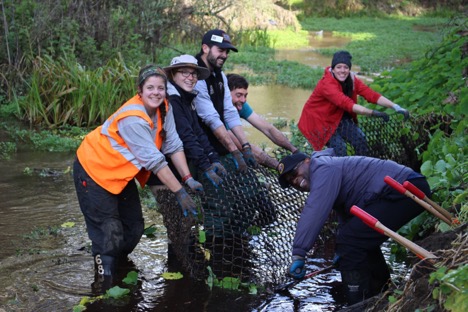
Photo Courtesy Yakuta Poonawalla
As we inch towards spring
We hear beautiful new sounds
The voices of birds sing
February, we hardly knew ya! The shortest month of the year did not lack for special moments—from planting out Franciscan manzanitas, to spotting the first signs of our rare and endangered annuals: the San Francisco wallflower and spine flower!
Announcements
Want to become a long-term Steward at Lands End? Read on!
If you love being outside, are interested in habitat restoration, and want to make a positive impact in your national park, we encourage you to sign up for our new Lands Ends Volunteer Steward Program!
This volunteer opportunity is different than our drop-in programs. Volunteers will be trained and be a part of the greater National Park Service Volunteer-In-Parks Programs. For more information, and to fill out the application, please click here.
A New Internship Opportunity with the Presidio Trust
Position Overview: Stewardship Volunteer Engagement Intern
This internship supports the Presidio Trust’s effort to engage thousands of volunteers each year in a variety of opportunities to support the Presidio. Working as part of a team, the intern will help coordinate and lead volunteers participating in park stewardship efforts. The intern will gain valuable experience in public engagement and event coordination through the delivery of volunteer service projects in the park. Click here for a full position listing.
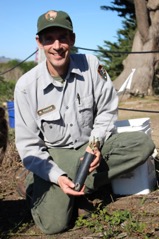
|
|
Photo Courtesy Yakuta Poonawalla
|
The Franciscan Manzanita on TV with the National Park Service’s Michael Chassé!
Follow the link to see the recent news report featured on CBS SF last month!
Events
For a complete list of upcoming events please visit the Presidio Trust and Parks Conservancy events homepages!
EXCLUSION: The Presidio’s Role in World War II Japanese American Incarceration
Tuesday–Sunday, 10 am–5 pm; through March 2018
Visit the Presidio Officers’ Club for an exhibit detailing the Presidio’s role in the incarceration of 120,000 Japanese Americans during World War II. What led to these dark events? What have we learned and how does this shed light on the current issues of mass incarceration, immigration reform, and racial profiling? For more information, please click the link.
March 3, 1–4 pm: TurnOut for Inclusion
To celebrate diversity and build community with our staff, volunteers, and visitors, we have teamed up again with TurnOut, an organization dedicated to connecting volunteers to LGBTQIA+ causes.
March 7, 6 – 7:30 pm: Betty Reid Soskin: Sign My Name to Freedom
A brief synopsis of the event from the San Francisco Public Library Website: National icon Betty Reid Soskin, 96, has been a war-years worker, a singer-songwriter, a performer, a legislative aide, a National Park Service ranger, and a tireless fighter against discrimination of all forms and for the growth and triumph of the human spirit.
Celebrate the accomplished life of this Bay Area hero with a conversation, reading, and book signing of her new memoir. Books will be available for purchase at the event. Location: Koret Auditorium, Main Library, 100 Larkin Street, San Francisco CA; Free Event.
March 10, 1–4 pm: South Asian Community Volunteer Day (Holi Special)
Celebrate South Asian cultures, traditions, and festivals in the company of nature at these special, family-friendly volunteer programs organized and hosted by park staff from within the community. Holi is a festival that marks the beginning of spring. We invite you to join us and enjoy the beginning of the wildflower blooms at Lands End on this festive day!
March 17, 10 am–2 pm: Women’s Spring Trail Day
Join an incredible group of women as we work together to create positive impact on the trail systems of our national parks. This will be an all-women’s trail event open to all self-identifying women, gender expansive, and non-binary folks ages 12 and up, led by the lady trail builders of the Golden Gate National Recreation Area, and supported by REI.
We will be working on the historic Dipsea Trail, two days after International Women’s Day, and one month before the 100th year anniversary of the first women’s-only Dipsea Walk/Run! Please join us for an empowering day of hope, collaboration, dirty hands, and delicious snacks.
March 10, 4:30–7:30 pm: Owls of Tennessee Valley
Join volunteer docent Steffen Bartschat on a hike in Tennessee Valley to search for and learn about the owls in the area. Bring water, layered clothing, a flashlight, binoculars, and a snack. Reservations required; please call the Marin Headlands Visitor Center at (415) 331-1540.
April 7, 9:30 am–2:30 pm: Give Back Kick Back
Give back during a morning volunteer event at Lands End…and then kick back "island style" at Fort Miley with incredible views, all hosted by the Parks Conservancy. 21+ only event but anyone can volunteer.

March Wildlife
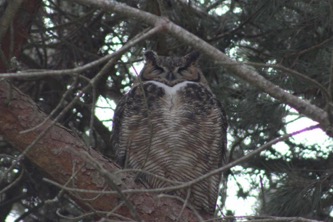
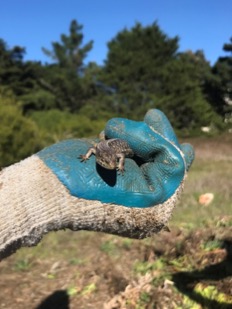
Great Horned Owl and Alligator Lizard
Photos Courtesy Vincent & Aurora
The Luck of the Clovers!
By Aurora Perez
Ecological Restoration and Volunteer Management Intern
March is filled with many special and fun holidays such as: I Want You to Be Happy Day (3/3), National Pi Day (3/14), and Take a Walk in the Park Day (3/30). One that stands out is Saint Patrick’s Day1—a day of celebrating Irish traditions, ancestry, and customs by honoring the patron saint of Ireland.
The shamrock is an iconic symbol of Irish heritage and culture. It appears on the flag of Erin Go Bragh, meaning “Ireland Forever” and a Saint Patrick’s celebration would be incomplete without it. While all shamrocks are clovers, not all clovers are shamrocks. The traditional shamrock is often confused with the four-leaved clover. So what’s the difference?
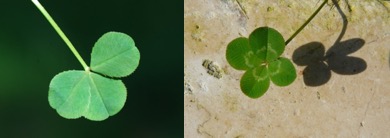
Photos Courtesy (left to right) Pancrat & Schnobby/Wikimedia Commons
The word shamrock comes from a Gaelic word meaning “little clover.” Clover is the common name for several species in the Trifolium family. The word trifolium translates to “having three leaves.” Irish legend claims that Saint Patrick used the shamrock to illustrate Christianity’s holy trinity of The Father, The Son, and The Holy Spirit. The three leaves are also said to represent faith, hope, and love
Four-leaved clovers are a rare mutation of the three-leaved clover. Because they are so uncommon, clovers with four leaves are considered lucky, but they are not considered to be shamrocks by those familiar with and passionate about Irish tradition2.
A very common plant found at parks, gardens, and open spaces all around San Francisco is Oxalis pes-caprae, commonly known as sourgrass and/or Bermuda buttercup. The leaves of Oxalis species are trifoliate, meaning they have three leaflets that radiate from a single point, making them very similar to clovers.
Some types of Oxalis are edible, or produce edible tubers. Oxalic acid gives the plant a sour taste, and in very large amounts, can actually be considered toxic. Both Oxalis and Trifolium have been associated with that traditional Irish symbol, the shamrock3.
San Francisco is full of fun things to do on Saint Patrick's Day, including the annual parade, festivals, and live performances. Every year, the United Irish Societies of San Francisco host a large Saint Patrick's Day Parade and Festival. This year, the holiday is on Saturday, March 17 and most festivities will take place that weekend.
What's a Weed? A Closer Look at Miner's Lettuc
By Michael Larkins
Ecological Restoration and Volunteer Management Intern
What is a weed? A plant whose virtues have not yet been discovered.
–Ralph Waldo Emerson
Sometimes the natural wonders of Golden Gate National Recreation Area compete for our attention. The scenic views of the Marin Headlands seen from the coastal bluffs. The Seal Rocks teeming with birds. The majestic Monterey cypress forest at Lands End. The many bird species that visit annually and our local aviary residents.
Competing with those are the wonderful historical and cultural wonders: the magnificent Sutro Baths ruins; the Ohlone middens (ancient monuments) at Lands End that strike wonder, awe, and reverence; the military batteries that are a timeless historical treasure. And these aren’t the only historical and cultural wonders worth our attention in the Golden Gate National Parks.
With all these sights competing for our attention, it’s sometimes challenging to notice what is right under our feet. One of the overlooked treasures in this area (perhaps because often times it’s hidden within a patch of panic veldt grass, oxalis, or nightshade), is Claytonia perfoliate—commonly known as miner’s lettuce.
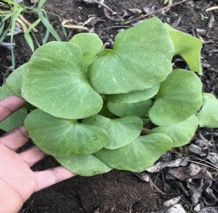
Photos Courtesy Michael Larkins
Although Claytonia perfoliata is found as far north as southern Alaska and as far south as Central America, it is most commonly found in California. It really does like cool, damp areas. However, it can be quite drought-tolerant in cool areas near the coast. It does well in many soil types, and blends in very well in a diverse plant community. A true Bay Area native, it has been designated by botanists as an indicator species. Its presence indicates an ecologically healthy area.
Claytonia perfoliata is classified as a California native plant because when the Europeans arrived in this area the indigenous people introduced it to them. The local historical and cultural significance of Claytonia perfoliata can be surmised from the origin of two of its common names: Indian lettuce and miner’s lettuce. So how did this plant actually come to have these common names?
There isn’t any documentation of the origin of the names. However, it can be inferred that the names were derived from the stories of two groups that used Claytonia perfoliata. According to Daniel Moerman, anthropologist and ethnobotanist, Claytonia perfoliata was used by Ohlone and Chumash Native Americans as an analgesic, eye medicine, and for rheumatic pain. They also ate the leaves fresh or boiled them as greens.
Later, California Gold Rush miners came across it in high abundance in the foothill mining locations. It became a food source they would eat during times when their food supplies were low or not available. Gold mining immigrants would also eat it because of its high concentration of vitamin C. It was one of the only ways that they could avoid developing scurvy.
The local historical and cultural significance of this native California plant is something for us to celebrate. The next time you see a batch of it during a walk to the park, perhaps a quiet reflection on its history will make it stand out from the background.

As the leaves continue to mature, the two lobes near the stem of the heart-shaped leaves grow closer together and eventually fuse to form a circle, and a flower bud forms in the center of the leaf.
Sources:
https://honest-food.net/on-miners-lettuce-americas-gift-to-salad/
https://www.theatlantic.com/health/archive/2011/03/foraging-for-miners-lettuce-americas-gift-to-salad/72106/
https://www.fs.fed.us/database/feis/plants/forb/claper/all.html
https://mailchi.mp/berkeley/the-jepson-videos-short-plant-id-videos-for-california-plants?e=8199667f28
Drop-In Volunteer Programs
|
Volunteer on Thursdays:
Presidio Coastal Bluffs, 1–4 pm
March 1, 8, 15, 22
April 5
Lobos Creek: March 29
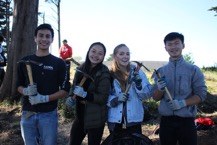
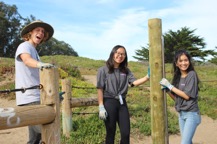
|
Volunteer on Saturdays:
Lands End, 1–4 pm
March 3, 10, 17, 24, 31
Cancellations: April 7
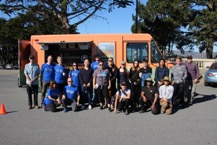

Photos Courtesy
Yakuta Poonawalla & Michael Larkins
|
|
Click here to find our volunteer work day schedule.
See you in the field!
|

|